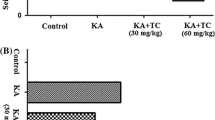Abstract
TheChongmyungtang (CMT; the combination ofAcorus gramineus, polygala tenuifolia andPoria cocos) has been recognized to possess the preventive effect against several neurologic disorders in human. In this study, we examined the effect of CMT on the three parameters associated with kainic acid (KA)-induced neurotoxicities; seizure/mortality, increased fos-related antigen (FRA) and glial fibrillary acidic protein (GFAP) expression. KA induced vigorous convulsions lasting 4–6 hr. Pretreatments with CMT before KA injection significantly reduced the seizure intensity as well as the mortality. CMT pretreatments also attenuated the KA-induced increase in FRA/GFAP expression in the hippocampus. These results suggest that CMT has a neuroprotective effect against KA-induced neurotoxicities.
Similar content being viewed by others
References Cited
Bing, G., McMillian, M., Kim, H. C., Pennypacker, K., Feng, Z., Qi, Q., Kong, L. Y., Iadarola, M. and Hong, J. S., Long-term expression of the 35000 mol wt. Fos-related antigen in rat brain after kainic acid treatment.Neuroscience, 73, 1159–1174 (1996).
Dash, P. K., Moore, A.N. and Dixon, E., Spatial memory deficits, increased phosphorylation of the transcription factor CREB, and induction of the AP-1 complex following experimental brain injury.J. Neurosci., 15, 2030–2039 (1995).
Greenamyre, J.T., Olson, J.M.M., Penny, J.B. and Young, A.B., Autoradiographic characterization of N-methyl-D-aspartate-quisqualate, and kainate-sensitive glutamate binding sites.J. Pharmac. Exp. Ther., 233, 254–263 (1985).
Huh, J.,Dongeuybokam (1st ed), Yuhkam Press, Seoul, 1994.
Meldrome, B. Possible therapeutic applications of antagonists of excitatory amino acid neurotransmitter.Clin. Sci., 68, 113–122 (1985).
Morgan, J. I. and Curran, T., Proto-oncogene transcription factors and epilepsy.Trends Pharmacol. Sci., 12, 343–349 (1991).
Kaczmark, L., Molecular bilogy of vertebrate learning: Is c-fos a new beginning?J. Neurosci. Res., 34, 377–381 (1993).
Kim, H.C., Pennypacker, K., Bing, G., Bronstein, D., McMillian, M. K. and Hong, J. S. The effect of dextromethorphan on kainic acid-induced seizures in the rat.Neurotoxicology, 17, 375–386 (1996).
Kim, H. C., Suh, H. W., Bronstein, D., Bing, G., Wilson, B. and Hong, J. S., Dextromethorphan blocks opioid peptide gene expression in the rat hippocampus induced by kainic acid.Neuropeptides, 31, 105–112 (1997).
Lee, C. R. and Benfield, P., Antiracetam: an overview of its pharmacodynamic and pharmacokinetic properties and a review of its therapeutic potential in senile cognitive disorders.Drugs and Aging, 3, 257–273 (1994).
Pennypacker, K. R., Walczak, D., Thai, L., Mason, F. E., Douglass, J. and Hong, J. S., Kainic acid induced changes in opioid peptides genes and AP-1 protein expression in the rat hippocampus.J. Neurochem., 60, 204–211 (1993).
Pennypacker, K. R., Thai, L., Hong, J. S. and McMillian, M. K. Prolonged expression of AP-1 transcription factors in the rat hippocampus after systemic kainate treatment.J. Neurosci., 14, 3998–4006 (1994).
Sperk, G., Kainic acid seizures in the rat.Prog. Neurobiol., 42, 1–32 (1994).
Stafstrom, C., Edwards, M., and Holmes, G., Status epilepticus following kainic acid administration: effect of age.Epilepsia, 30, 673–679 (1989).
Stores, G., Cognition function in children with epilepsy.Dev. Med. Child. Neurol., 13, 390–393 (1971).
Tanaka, H., Araki, M. and Masuzawa, T., Reaction of astrocytes in the gebril hippocampus following transient ischemia: Immunohistochemical observations with antibodies against glial fibrillary acidic protein, glutamine synthetase, and S-100 protein.Exp Neurol., 116, 264–274 (1992).
Author information
Authors and Affiliations
Rights and permissions
About this article
Cite this article
Jang, KJ., Lee, KH., Kim, SL. et al. Chongmyungtang attenuates kainic acid-induced seizure and mortal effect in the mouse. Arch. Pharm. Res. 20, 375–378 (1997). https://doi.org/10.1007/BF02976204
Received:
Issue Date:
DOI: https://doi.org/10.1007/BF02976204




